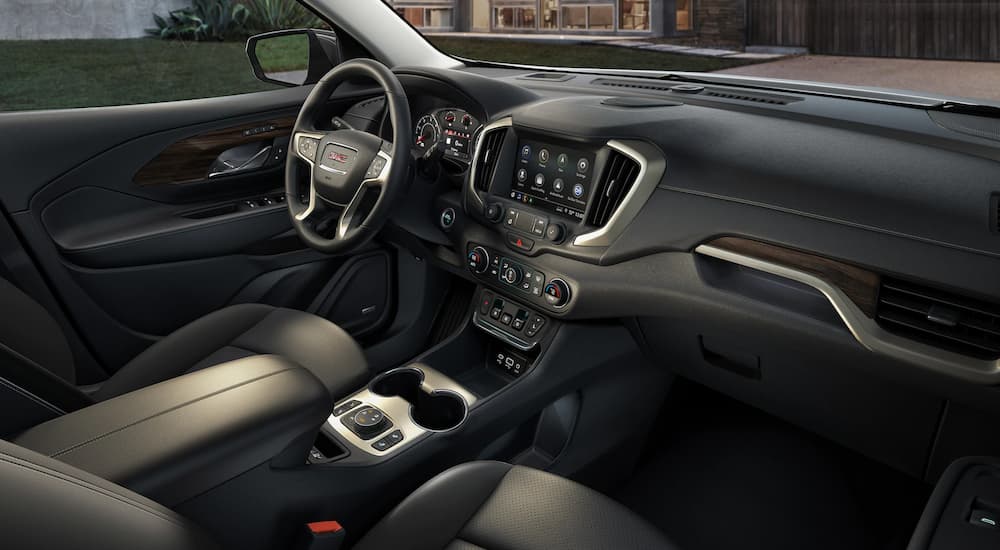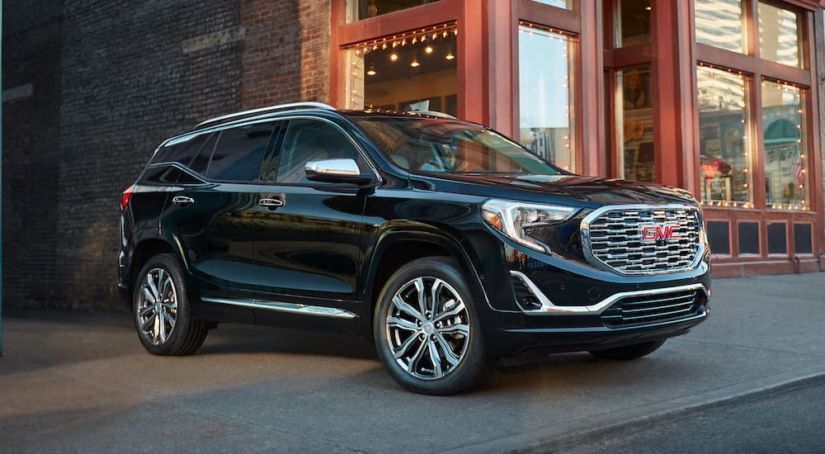Crossover SUVs are everywhere. Just about every automaker in the world has at least one, and many have multiple across their lines. The reason for this is simple: they are extremely popular. The public has shown an overwhelming demand in the last decade or so, and the auto companies are supplying them. So, when you are looking for a new crossover SUV, such as a 2019 GMC terrain vs 2019 Hyundai Santa Fe, you certainly have your work cut out for you.
These two crossover SUVs are just a small sample size in an ever-growing market. Passenger and family sedans are dying out at an alarming pace, and these crossover SUVs are replacing them. And why not? They are larger than sedans and coupes, and offer the same interior options in the way of infotainment and safety features. They are not as large as the full-sized SUVs, making them easier to navigate and park. They typically have the same, or better, gas mileage than a car and far better fuel efficiency than a bigger SUV or pickup truck. They are stylish and versatile. They offer everything that a family sedan once did, and more.
The only problem with this revolutionary vehicle is that there are dozens of them to choose from. While we cannot possibly hope to cover all of them here, we can at least help you out with two of these crossover SUVs, the 2019 GMC Terrain and the 2019 Hyundai Santa Fe.
Engines
The 2019 GMC Terrain offers three engine options. The first is a 1.5-liter 4-cylinder that gets 179 horsepower and 203 lb-ft of torque. That may not seem like much under the hood, and it really isn’t, but it is perfectly adequate for a crossover SUV of this size. More importantly, however, is that it gets 30 miles to the gallon on the highway.
If you are looking for a little more power, the 2019 GMC Terrain also offers a 2.0-liter 4-cylinder with 252 horsepower and 260 lb-ft of torque. That is significantly more muscle and doesn’t sacrifice much in the way of fuel efficiency, as it still gets 28 highway miles per gallon. For those who are fans of diesel engines, the Terrain also has one of those. The Terrain’s turbo-diesel is a 1.6-liter 4-cylinder that gets 137 horsepower and 240 lb-ft of torque. That may be a step down in the power department from the 2.0-liter, but it does get 39 miles to the gallon on the highway. That extra investment in the diesel engine could pay off in a few years, depending on how much you drive.
The 2019 Hyundai Santa Fe, on the other hand, only offers two engines in the US market. The 2.4-liter inline 4-cylinder gets 185 horsepower and 178 lb-ft of torque, while the 2.0-liter inline 4-cylinder gets 235 horsepower and 260 lb-ft of torque. These are comparable in size and performance to those of the Terrain, but sacrifice a little when it comes to fuel efficiency, as they only get 29 highway miles and 25 highway miles, respectively. Hyundai had announced a diesel engine option for the North American market in 2018, but canceled it due to a lack of interest in the US. This engine option is available in Asian markets, if you really, really want it.
Interior Space

Part of the appeal of the crossover SUV is that it has the versatility of both a sedan and a sport utility vehicle. It may drive like a car, but it has far better, and more easily accessible, cargo space. That is one feature that makes it ideal for a family vehicle. If you have kids, then you know your cargo area is a precious commodity. Between book bags, school projects and the copious amounts of groceries, you will invariably need every inch of cargo room that a crossover SUV has to offer.
The 2019 Hyundai Santa Fe offers a total of 110.7 cubic feet of interior space. That is plenty of leg and head room for both the front and rear passengers. That includes 35.9 cubic feet of space behind the second row. When the second row is folded down, that number more than doubles to 71.3 cubic feet. These numbers are about average for the class.
The 2019 GMC Terrain, however, only offers 81 cubic feet of space. This includes just 29.6 cubic feet behind the second row and 69.3 cubic feet when the second row is folded down. The interior space is well below the average in its class.
Both models offer power and hands-free liftgates on higher trim levels. These liftgates are very useful when you are lugging those book bags and groceries and don’t have a free hand to open the rear of the car. You aren’t likely to find that kind of amenity for a car’s trunk.
While the Hyundai Santa Fe is perfectly average in this category, the GMC Terrain doesn’t quite measure up. If you need all the interior space you can get, the 2019 Hyundai Santa Fe is definitely the better option.
Trim Levels
Customization in any vehicle is a highly desirable trait. With the boom of automotive technology over the last two decades, there are more options for infotainment and safety features than ever before, and those lists promise to grow ever-longer in future vehicle generations. However, not everybody needs all the perks and options these automakers have to offer. This is especially true for those who are on a limited budget, as more features means a higher sticker price. Being able to select the right vehicle, with all the desired features, is the reason why trim levels exist.
The 2019 Hyundai Santa Fe currently comes in seven different trim levels and fourteen configurations, after factoring in all-wheel and front-wheel drive options. Those trim levels are the SE 2.4, the SEL 2.3, the SEL Plus 2.4, Limited 2.4, Limited 2.0T, Ultimate 2.4 and the Ultimate 2.0T. As with any vehicle, the base level (SE 2.4) offers several standard features, and as you move up through the ranks, you get more and more perks as standard until you get to the aptly named Ultimate 2.0T. There, you will get all the creature comforts that the 2019 Hyundai Santa Fe has to offer.
Later in 2019, Hyundai will introduce the Hyundai Santa Fe XL. Even though this vehicle bears the Santa Fe nameplate, it will be a virtually completely different vehicle. The current incarnation of the Santa Fe is a two row, five-seater, while the Santa Fe XL will be a three row, seven-seater SUV. Why Hyundai is insistent on calling this vehicle a Santa Fe is unclear. It may just add confusion to an already cluttered Santa Fe lineup.
The 2019 GMC Terrain has only four true trim levels, but counts six, as the diesel engine accounts for two trim levels of its own. Those are the SL, the SLE, the SLT, the SLE Diesel, the SLT Diesel and the Denali. Some may see this as a sleeker, less confusing lineup, while some may see it as not offering the same customization options as the Hyundai Santa Fe. Either way, the same rules apply. The higher you go on the trim levels, the more cool stuff you get. Luckily, with the Terrain the base model comes loaded with standard features that are usually found on higher trim levels for other brands.
If you look at experts’ lists of the best crossover SUVs on the market, you will not find either of these at the top. You are more likely to find the 2019 Hyundai Santa Fe ranked higher, though. That may be in part because the Santa Fe is an established nameplate since 2000, while the Terrain entered into an incredibly crowded field ten years later. It is sometimes very difficult to remove yourself from the middle of the pack. That appears to be the challenge the Terrain now faces but it’s doing a commendable job and has a bright future.



